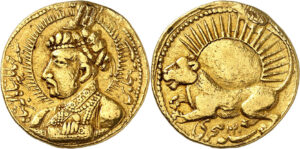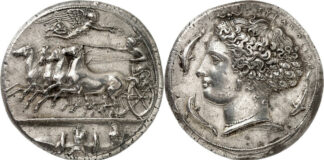Numismatica Genevensis: Where the Most Beautiful Coins Are Sold
A royal collection – that was the motto of the first catalogue of Numismatica Genevensis SA. And there was no doubt about the royalty of the material, whether it be in the first or in the second catalogue. For once, we do not want to start with the highest results, which were quite impressive considering that hammer prices up to CHF 1.7 million were achieved. First of all, we want to show you a piece with a modest estimate of CHF 2,000.

This dollar was minted in 1893 and bears the date of 1891 and the portrait of the last Queen of Hawaii. By the way, the Queen herself was not responsible for this dollar – the then renowned coin collector Reginald Huth commissioned the private London mint Pinches & Co to produce these splendid trial pieces in the name of the Queen of Hawaii. Only 50 specimens were minted, thus, these coins are extremely rare. Additionally, the offered piece was of outstanding quality: PCGS graded it PR64. Therefore, bidders were willing to pay far more than the estimate. Thus, the coin, which had appeared to be rather inconspicuous in the catalogue, achieved a result of impressive CHF 30,000 – the fifteenfold of the original estimate.

A trial piece of the dollars of military leader Yuan Shih-Kai, who was Emperor of China from 15 December 1915 to 22 March 1916 and President of the Republic of China until 6 June 1916, increased tenfold in price – it was sold at CHF 100,000, the estimate had been CHF 10,000.
Dollars with the portrait of Yuan Shih-Kai are no rarities, but the piece offered at Numismatica Genevensis SA was no ordinary dollar, but a trial piece of this important issue of outstanding quality.
According to a guideline published by the US Department of Commerce in 1926 for American citizens trading with China, the Chinese government had been planning to introduce coins in the Western style for the entire empire since 1914. These coins, which became known as Yuan Shih-Kai dollars, contained 89% of silver and 11% of copper. At the time the aforementioned book was written, they accounted for about 80% of the silver money circulating in China. Although these coins were of stable fineness and weight, the Department of Commerce advised against using them for the purpose of financial transactions. When it came to the settlement of bills, they said, it was best to insist on a payment in tael.
Therefore, the trial piece offered at Numismatica Genevensis is a unique testimony to the opening of China to the West. Thus, it’s no surprise that this trial piece achieved such a high result.

The price of a family rouble graded MS64+ by PCGS was six times higher than its estimate. Whereas the estimate had been CHF 30,000, the piece was sold at CHF 180,000.
Do we actually need to say something about the background of Russian family roubles? All coin lovers know how rare these pieces are. Only 150 specimens of this variety were minted. Moreover, these family roubles are the only coins featuring the portrait of Tsar Nicholas I, otherwise his face can only be found on medals.
The preceding lot, a variety of the type that was even rarer and of which only 50 specimens were minted, sold at a price of CHF 230,000.
Let’s conclude this review with a glance at what was probably the most spectacular ensemble of coins that was on offer. In terms of wealth, quality and variety, a series like the 25 gold coins from the Mughal Empire has never been seen on the market before. Obviously, they attracted great interest.

Among all these rarities, the first coin of the series still stood out. It is a mohur of Akbar the Great, whose shape was clearly inspired by a mihrab, a prayer niche.
But this wasn’t the only thing that made this coin unique: Akbar also introduced a new denomination, the mohur, that was to influence the gold coins of the Mughal Empire for a long time. The ruler established his own era, the Ilahi era, according to which this coin is dated. It was minted in Agra in the fifth month, the month in which the sun is in the sign of Leo. The piece had an estimate of CHF 500,000 and was sold for CHF 550,000. Including the premium, the proud new owner paid CHF 660,000 for this rarity from the Mughal Empire.

A gold mohur of Jahangir minted in the 6th year of his reign was sold at a hammer price of CHF 200,000 – the double of its estimate. The obverse features the impressive portrait of the Mughal emperor. Instead of the glass, which is frequently depicted on other coins, Jahangir holds a book in his hand. The reverse depicts the zodiac sign of Leo.
As all of his ancestors, Jahangir was extremely interested in astronomy. His stunning series of coins featuring zodiac signs bears testimony to this – Numismatica Genevensis was able to offer no less than twelve of these pieces. All lots were sold at impressive prices, with Aries and Capricorn (CHF 275,000 each) as well as the second Capricorn (CHF 280,000) achieving the highest results.
We would like to briefly mention some other results at this point: For example, the CHF 1.7 million paid for a magnificent tetradrachm of Cimon featuring the frontal portrait of Arethusa on the obverse (estimate: CHF 1.5 million). Or the CHF 800,000 paid for the gold medal with the splendid Renaissance portrait of Queen Mary Tudor made by Jacopo Nizzola da Trezzo (estimate: CHF 500,000). Not to forget the CHF 750,000 for a tenfold ducat of Ferdinand II, minted in 1626 in Wrocław, and the same sum paid for a tenfold ducat of Ferdinand III minted in 1648 in Kremnica (estimate: CHF 500,000 each).
The medal auctioned to support the restoration of Notre-Dame was sold at a price of CHF 170,000.
You can find the lists of the results of auction 11 and auction 12 on Biddr.
Numismatica Genevensis runs auctions for high quality coins at irregular intervals. If you would like to consign outstanding pieces, do not hesitate to contact them: Numismatica Genevensis SA, Rond-Point de Plainpalais 1, CH-1205 Genève, phone: +41 / 22 / 320 46 40, Email
Please note, Numismatica Genevensis is not interested in pieces that are not of outstanding quality and rarity.




